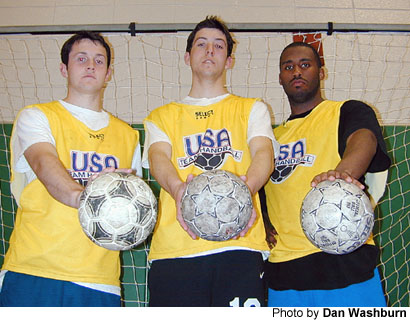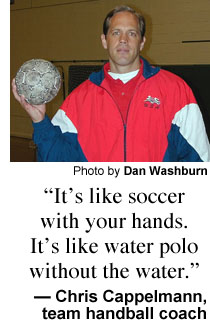
March 27, 2001 — I wanted to dribble. Or throw the ball down on the ground and kick it.
Moving with the ball in my hand felt awkward, and seemed like it should be illegal.
Everything about team handball was completely foreign to me — yet oddly familiar.
“It’s just catching, passing, throwing, running — everything Americans do,” explained Chris Cappelmann, head coach of the US Junior Men’s Pan American Team that I practiced with last week in Kennesaw. “But it’s totally different from anything we know.”
And that makes the Olympic sport of team handball kind of hard to describe. Cappelmann tried, though.
“It’s like soccer with your hands,” he said. “It’s like water polo without the water.”
 As the practice went on, Cappelmann also likened aspects of the game to basketball, lacrosse, rugby and ice hockey. Team handball is an amalgam. It’s an anomaly.
As the practice went on, Cappelmann also likened aspects of the game to basketball, lacrosse, rugby and ice hockey. Team handball is an amalgam. It’s an anomaly.
“It’s addicting,” said 19-year-old Ryan Hansell, of Marietta, a wing on the US team. “Once you start playing, it gets in your blood.”
Team handball is fast-paced and physical. The indoor court is roughly 66 feet wide and 131 feet long, with goals on either end that are about half the size of those used in soccer. Two teams of seven players pass, dribble and shoot a leather ball about the size of large cantaloupe.
Only the goalie is allowed within a 6-meter arc around the goal. Running more than three steps with the ball and holding it for longer than three seconds is illegal. Only the goalie can kick the ball.
“As a coach, you have to be very patient,” Cappelmann said. “It’s easy to learn, but hard to master. You fail in this sport a lot before you succeed. Mentally, you have to be prepared to handle that.”
Cappelmann’s team is training for the 2001 Men’s Junior Pan American Championship, which runs April 4-8 at the Georgia International Convention Center in College Park. Teams representing Argentina, Brazil, Canada, Chile, Colombia, Mexico, Puerto Rico and the United States will compete. The top two teams qualify to represent North America at the World Championships, Aug. 19-Sept. 2 in Switzerland.
Twelve of the 16 players on the US roster hail from Georgia. Most of them are from Cobb County. That is not by accident.
Since the 1996 Olympic Games in Atlanta, Cobb has turned into team handball central. The county is home to Atlanta Team Handball and the nation’s brightest young talent — most of whom had never even heard of the sport before middle school.
“The Olympic team did demonstrations at the different schools,” said goalie Stephen Futral, 19, of Acworth. “It was brand new to me when I saw it.”
“I thought it was fast and fun,” added Hansell. “We definitely were in the right place at the right time.”
Sound familiar? It should. Gainesville’s Lanier Canoe & Kayak Club, another legacy of the Atlanta Games, has made similar grass-roots gains in developing top-level young athletes in another obscure Olympic sport, sprint canoe/kayak.
“What’s happening in Cobb County isn’t happening anywhere else in the country,” Cappelmann said. “They are the best at what they do right now, but there’s not a lot of people doing what they’re doing.”
Team handball was developed in Europe in the 1920s and made its Olympic debut in 1936. After that, it didn’t reappear until 1972 for men, 1976 for women. The US men’s team has never placed better than ninth in Olympic competition. The US women finished fourth in 1984.
“In Europe, it’s just as big as the NBA,” said Cappelmann, a member of the US national team from 1985-1991. “You either play soccer or you play team handball. It’s just that simple.”
But it’s not so simple for Americans — brought up on basketball, football and baseball — who don’t see team handball on television and don’t read about it in the newspaper. Even the best athletes struggle at first.
“It’s like basketball, but there are certain principles that are different,” said US player Luqman Salam, 19, of Smyrna, who also plays football at the University of the South in Sewanee, Tenn. “Like dribbling. You don’t want to dribble. You have to break yourself out of dribbling.”
And that can take years, according to most of the players I talked to. So what was I supposed to do in a couple of hours?
“When Dan feels comfortable, he can jump in,” Cappelmann said to the group. “If you want to abuse him, you can.”
Comfortable wasn’t going to come quickly, so I rubbed some pine tar on my hands and jumped on in.
And I didn’t dribble once. Of course I didn’t do much of anything else, either.
